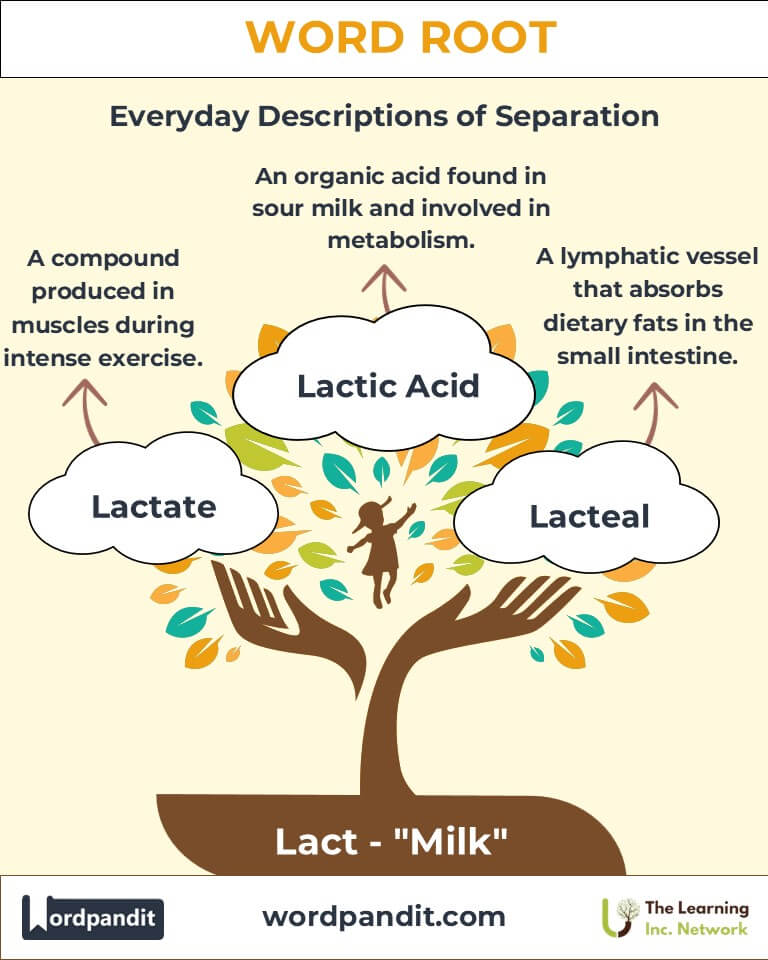Lact: The Nourishing Root of Milk and Its Derivatives
Byline: Delve into the rich etymology and utility of the root "lact," derived from Latin, meaning "milk." From its presence in everyday terms like "lactose" to specialized fields such as medicine and biochemistry, "lact" weaves a story of nourishment and biological significance across cultures and disciplines.

Table of Contents
- Introduction: The Essence of Lact
- Etymology and Historical Journey
- Mnemonic: Unlocking the Power of Lact
- Common Lact-Related Terms
- Lact Through Time
- Lact in Specialized Fields
- Illustrative Story: Lact in Action
- Cultural Significance of the Lact Root
- The Lact Family Tree
- FAQs About the Lact Word Root
- Test Your Knowledge: Lact Word Root Quiz
- Conclusion: The Enduring Legacy of Kerat
Introduction: The Essence of Lact
What connects a glass of milk to advanced medical treatments? The answer lies in the root "lact," pronounced lakt, which originates from the Latin word lac meaning "milk." This root is central to words that describe milk-related substances, processes, and characteristics, from lactose (the sugar in milk) to lactate (a product of lactic acid metabolism). The influence of "lact" spans biology, nutrition, and medicine, symbolizing sustenance and life.

Etymology and Historical Journey
The word root "lact" is derived from the Latin lac, which translates directly to "milk." In ancient Rome, milk was a vital dietary component, celebrated for its nourishing properties. Over time, the root found its way into multiple languages, enriching scientific terminology and everyday vocabulary. During the Renaissance, as Latin reemerged in medical and scientific texts, lact- became a cornerstone for describing milk-based products, bodily functions, and chemical compounds.
Mnemonic: Unlocking the Power of Lact
Imagine a warm glass of milk with the word "LACT" written in frothy foam on its surface, signifying the nourishing essence of the root.
Mnemonic Device: “Lact leads to life’s nutrition, from lactose to lactation!”
Common Lact-Related Terms
- Lactose (lak-tohs):
- Definition: A sugar found in milk and dairy products.
- Example: "Lactose intolerance is a common condition affecting the digestion of dairy."
- Lactate (lak-teyt):
- Definition: A compound produced in muscles during intense exercise, also related to lactic acid.
- Example: "High-intensity workouts often lead to lactate buildup in muscles."
- Lactation (lak-tey-shun):
- Definition: The production and secretion of milk by mammals.
- Example: "Lactation provides essential nutrients for newborns."
- Lactic Acid (lak-tik as-id):
- Definition: An organic acid found in sour milk and produced during anaerobic respiration.
- Example: "Lactic acid accumulation can cause muscle fatigue after exercise."
- Lacteal (lak-tee-uhl):
- Definition: A lymphatic vessel that absorbs dietary fats in the small intestine.
- Example: "The lacteals play a crucial role in nutrient absorption."
Lact Through Time
- Lactic Acid Fermentation:
- Historical Use: Fermentation techniques in ancient cultures harnessed lactic acid bacteria to produce yogurt, cheese, and other dairy products.
- Modern Context: Lactic acid fermentation is now a cornerstone of food science and biotechnology.
- Lactose Discovery:
- Timeline: Identified in the early 17th century, lactose became crucial in understanding human digestion and dairy chemistry.
Lact in Specialized Fields
- Biochemistry:
- Lactate Dehydrogenase (LDH): An enzyme that converts lactate to pyruvate, critical in cellular metabolism.
- Application: LDH levels are used to diagnose tissue damage and metabolic disorders.
- Nutrition:
- Lactose-Free Products: Designed for those with lactose intolerance, these products ensure milk's benefits without digestive discomfort.
- Medicine:
- Lactation Consultation: A medical field dedicated to supporting breastfeeding mothers and addressing challenges like mastitis.
- Food Industry:
- Lactic Acid Bacteria: Used in producing fermented foods, enhancing flavor, texture, and preservation.
Illustrative Story: Lact in Action
Emma, a marathon runner, found herself battling muscle cramps during training. Her coach explained that lactate buildup in her muscles was a natural byproduct of intense exercise. With a tailored diet including lactase supplements to manage her lactose intolerance, Emma was able to include nutrient-rich dairy products in her meals. Her journey exemplified how understanding the root "lact" can improve both health and performance.
Cultural Significance of the Lact Root
The root "lact" has deep cultural ties, symbolizing nourishment, motherhood, and life itself. Across civilizations, milk has been a dietary staple, revered for its life-sustaining properties. In mythology, the "Milky Way" galaxy reflects humanity's association of milk with creation and abundance. Additionally, fermented milk products like yogurt and cheese have become cultural icons, showcasing the root’s enduring relevance.

The Lact Family Tree
- Galact- (Greek: "milk"):
- Examples: Galactose (a milk sugar), galactic (relating to the Milky Way).
- Casein- (Latin: "cheese"):
- Examples: Casein (milk protein used in cheese production).
- Dairy- (Old English: "related to milk"):
- Examples: Dairy (milk-based products), dairyman (milk farmer).
FAQs About the Lact Word Root
Q: What does the root "lact" mean?
A: The root "lact" comes from the Latin word lac, meaning "milk." It forms the basis of terms related to milk and its biological or chemical properties, such as "lactose" (milk sugar) and "lactation" (milk production).
Q: What is lactose?
A: Lactose is a natural sugar found in milk and dairy products. It consists of two simpler sugars, glucose and galactose, linked together. For lactose to be digested, the enzyme lactase must break it down into its simpler components.
Q: What is lactation?
A: Lactation is the process by which mammals produce and secrete milk through their mammary glands. It is essential for nourishing newborns and provides them with vital nutrients and antibodies for early immunity.
Q: What causes lactose intolerance?
A: Lactose intolerance occurs when the body produces insufficient amounts of lactase, the enzyme required to digest lactose. This condition can lead to symptoms like bloating, gas, and diarrhea after consuming dairy products.
Q: What is lactic acid, and where is it found?
A: Lactic acid is an organic compound produced during anaerobic respiration (when oxygen levels are low) in muscles. It is also present in sour milk and is used in the production of fermented foods like yogurt and cheese.
Q: How does lactate relate to exercise?
A: During intense physical activity, muscles may rely on anaerobic respiration for energy, leading to lactate production. While lactate itself isn't harmful, its buildup can contribute to muscle fatigue and soreness.
Q: What are lacteals, and what do they do?
A: Lacteals are specialized lymphatic vessels located in the small intestine. They play a critical role in the digestion process by absorbing dietary fats and transporting them into the lymphatic system.
Q: Is lactose only found in milk?
A: While lactose is most commonly associated with milk and dairy products, it can also be found in processed foods that use dairy ingredients, such as baked goods, candies, and sauces.
Q: How is the root "lact" used in non-biological contexts?
A: Though primarily associated with biology, "lact" can appear metaphorically in contexts like "milking the opportunity," symbolizing extracting something valuable, similar to the act of drawing milk.
Test Your Knowledge: Lact Mastery Quiz
1. What does the root "lact" mean?
2. What is the sugar found in milk?
3. What is the role of lactate in exercise?
4. What term describes milk production in mammals?
5. What enzyme is needed to digest lactose?
Conclusion: The Living Legacy of Lact
The root "lact" embodies nourishment, connection, and biological processes that sustain life. From its role in describing milk's natural components to its scientific applications in health and nutrition, "lact" remains vital across disciplines. As dietary trends evolve and scientific advancements continue, the legacy of "lact" will persist, reminding us of the fundamental role of milk in human history and biology.












